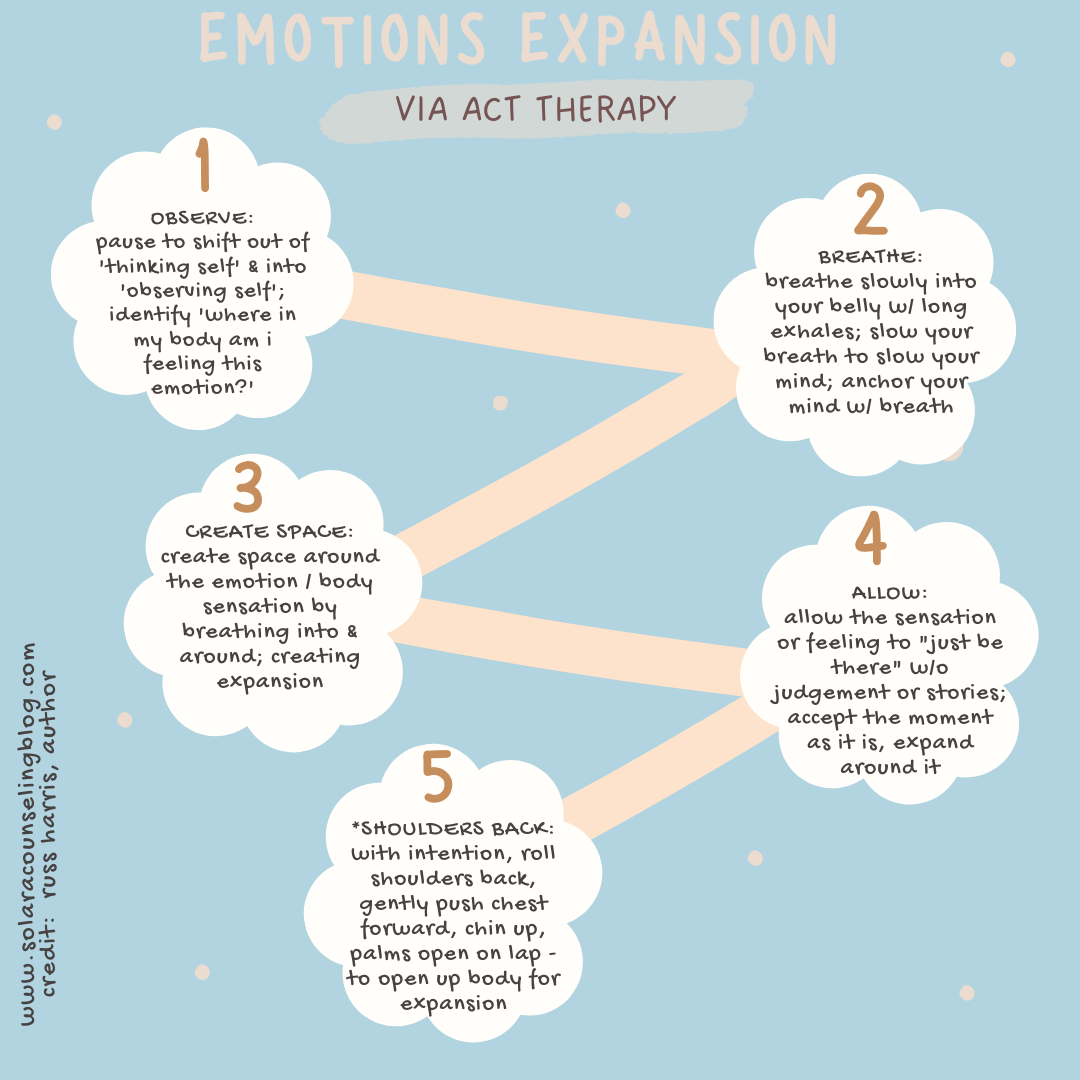Expanding Around Our Emotions - via ACT Therapy
EMOTIONS EXPERIENCING VIA ACT THERAPY
EXPANDING AROUND EMOTIONS
Last in this series on ‘feeling your feelings’ (the difficult ones…) is a practice derived from ACT Therapy. ACT is short for Acceptance and Commitment Therapy. ACT is a form of cognitive behavioral therapy (CBT) that focuses on how we conceptualize and process our thoughts, worries, emotions and fears. ACT utilizes interventions that focus on acceptance of feelings/thoughts when they occur … using cognitive-oriented tools such as defusion from problematic thoughts, mindfulness to pause and access ‘observing self’ and making ‘values guided choices’ that help us move toward what we most value in life.
One of the cognitive / mindfulness based practices used in ACT therapy involves “expanding ourselves to make room for feelings” - and was developed by Russ Harris (book reference below). As Harris describes, sometimes our emotions feel “too big” and so difficult that we also feel they might “pull us apart” or “stretch us beyond our limits”. When this happens - we tend to curl up, shrink in avoidance, numb or distract in unhealthy ways. Being able to sit with the feeling, ‘expand’ around the emotion and hold it mindfully can ease this tension.
PRACTICING EXPANSION - THE 4 STEPS
OBSERVE -
To start the expansion practice, you’ll need to shift into “observing self”…. and step out of your “thinking self”. Recognize the stories and narratives of the “thinking self” that emerge with a difficult emotion or feeling. Allow yourself to shift out and into a ‘wide angle lens’ mode, dropping out of ‘story mode’. Start with pausing, scanning your body to find where you are feeling the emotion - tight chest, teary eyes, etc. Observe how it feels, where it’s most intense, whether it moves to other parts, whether you feel cold or warm, etc… internally check in with yourself using curiosity - not judgement.
BREATHE -
Breathe into and around where you find the sensation in your body. Start with slow deep inhales or ‘belly breaths’ into and around the sensation. Pause after each inhale, hold briefly and then engage in slightly longer exhales… ‘letting it all out’ on exhales. Remember that slowing down your breath = slowing down your mind. Let your breath be your “anchor” and help you connect with your body and your feeling.
CREATE SPACE -
As you breathe into the feeling, you are creating space within your mind and body for the emotion. This reduces the tightness and helps to create the expansion. Visualize the expansion around the feeling or sensation. Allow your mind and body to ‘open up’ rather then ‘close and tense’.
ALLOW -
Allow the sensation and the feeling to '“just be there”… “let it be”. If your mind starts creating stories or narratives around the feeling, just gently respond to yourself with “Thanks, Mind… there you are: I see you… I know you’re trying to protect me but I’ve got this, I can manage it”.
Remember that your reflex will be to push the feeling away or even fight with it… acknowledge the reflex and bring your awareness back to ‘observing self’ and to the sensation in your body. “Let it be” and remember that “your goal is to make peace with the feeling, to let it be even if you don’t like it or want it”. You are accepting the moment as it is and willing to expand around it.
*Extra Step - ‘Shoulders Back’ Body Positioning for Expansion
How we hold our bodies is both affected by our emotions and can reversely affect how we feel. Often when we are stressed, sad, frustrated, feeling badly - we tense up, cave our shoulders forward, head faces downward and we droop forward into ourselves.
To counter this body response, practice the ‘shoulders back’ pose: With intention, roll your shoulders back gently so that they more open. Gently hold your chest upward and outward with chin rising. Envision expanding your chest, shoulders resting back, chin up so your face is toward the sky or sun, keep eyes open or closed, rest your hand on thighs with palms up and take a few deep belly breaths. This can be helpful along with the ACT emotions expansion process.
Best, Jenn
Reference / Book Recommendation: The Happiness Trap - How to Stop Struggling and Start Living; A guide to ACT: the mindfulness-based program for reducing stress, overcoming fear, and creating a rich and meaningful life.
*The information presented in this blog is intended for general knowledge and use only. It should not take the place of medical, clinical advice or licensed therapy. To find a licensed practitioner in your area, the Psychology Today Directory is an excellent resource.

